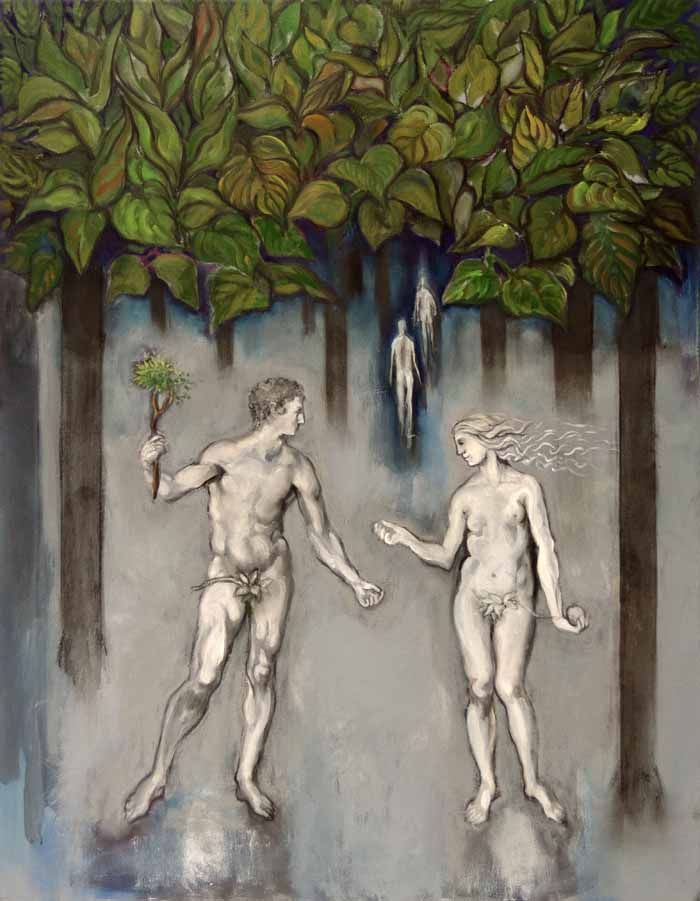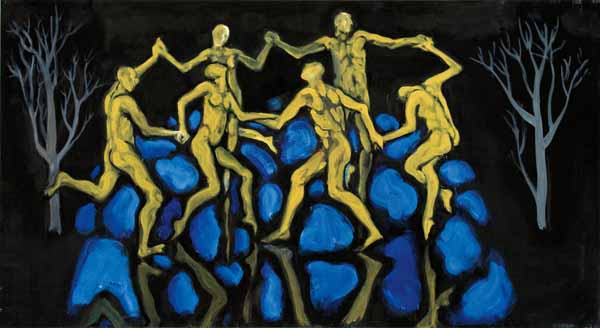OEUVRE
Artist Series
by Renee Radell
At various times in her 70-year painting career, Renee Radell has created artist series from painting ideas that range from landscapes , to abstract music painting to more complex allegorical themes steeped in symbolism and at times, surrealism .
In excerpts from Renee Radell Web of Circumstance, award-winning author and art critic Eleanor Heartney provides not only descriptive information about several key artist series pictured below, but insightful narrative about Renee Radell’s use of symbolism, surrealism and allegory.
Artist Series: Walk in the Park
“Adam and Eve reappear in one panel of the series, Walk in the Park (2011). Again the theme is the journey through life, this time using the metaphor of the forest glen. This series follows groups of figures walking through groves of trees or standing in clusters among dense foliage. The series conjures up the opening line of Dante’s Inferno, in which the narrator finds himself lost, in the middle of life, in a dark forest. For Dante the forest represented the plunge into the uncertainties of middle age, which became, for his narrator, a journey through heaven, hell and purgatory. For Radell as well, the forest represents a place of self-discovery and a journey that may be simultaneously frightening, exhilarating and deeply transformative.
Artist Series: Carnival of Flight
“Closely related to the Walk in the Park paintings is the Carnival of Flight (2010) series. Here groups of figures dance exultantly within a forest. In some paintings they hold hands, forming a circle in a manner that brings to mind Matisse’s The Dance. In other paintings, they break apart to dance in pairs or singly, and in one painting they seem to turn from dancing to fleeing from, or being drawn toward, the unknown. The series culminates in Wishing Well (2010), in which dancers encircle a vortex in the sky – the wishing well of the title. There is both a promise of dream fulfillment and a hint of danger here, reminding us that life itself is a mix of peril and pleasure.”
Artist Series: The Puppet House
“In the early 1990s, Radell created a series of paintings that ultimately formed a loose narrative she titled The Puppet House. The Puppet House series developed into an allegory of the awakening of the creative imagination and its ongoing resistance to the neutralizing power of reason. The initial inspiration for the series was a puppet she discovered in the window of a folk-art shop in New York. This wooden toy, a dapper, stylized boy in a sailor-like costume, became the protagonist in a narrative that brought to life the numerous objects that populate the shelves in her studio.
Other characters appeared, including Charlotte, a detached doll’s head who eventually becomes a real girl; a King and Queen who preside over the world, brought to life by the imagination; and a wooden bird who assists the escape from reason. The only genuine human in the series, aside from Radell herself, who presides over the unfolding drama from its outset in The Introduction (1990) is her husband Lloyd. As The Visitor (1994), he is admitted into the inner sanctum of the story, just as he has always been the privileged observer of the works unfolding in his wife’s studio.”
In addition to these allegorical artist series, Renee Radell has created series using painting themes of portraits, heads, brides, “plantscapes”, “Raindrops”, landscape in both Europe and the United States, and several abstract ideas such as abstract music painting.
Walk in the Park
The Puppet House



























